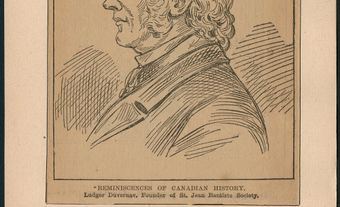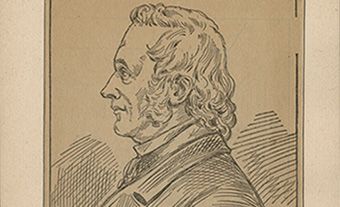Book Publishing, French-Language
It is generally agreed that there was no publishing in New France. William Brown and Thomas Gilmore installed the first presses in Québec City in 1764 and Fleury Mesplet in Montréal in 1776. These presses were used primarily for NEWSPAPERS, but also filled some printing contracts for the government, the army, the clergy and various merchants. Thus the first French-language or bilingual publications were official government texts, pastoral letters from the bishop, religious books, textbooks and advertisements.
During the 19th century most books continued to be imported and commerce was largely controlled by the British under terms of the Navigation Acts, which were not finally abolished until 1849. Few literary works were published in any quantity. Most 19th-century literature appeared in newspapers or MAGAZINES, the exceptions being publications such as Épitres, satires (1830) by Michel Bibaud, L'Influence d'un livre (1837) by Philippe-Ignace-François AUBERT DE GASPÉ, and Les Fiancés de 1812 (1844) by Joseph DOUTRE.
Since authors had to show guaranteed sales before they could get a contract with a publisher, many writers were involved in founding literary magazines; J.O. Letourneux, for instance, established La Revue canadienne in 1845, its L'Album devoted to literature, and the newspaper La Minerve launched l'Album littéraire et musical de la Minerve in 1849. James Huston, in le Répertoire national (1848-50), published a collection of literature which had appeared first in newspapers, and Henri-Émile Chevalier founded La Ruche littéraire in 1853 for the same reason. Then came the great national literary magazines: Les SOIRÉES CANADIENNES (1861), Le Foyer canadien (1863) and la Revue canadienne (1864) (see LITERARY PERIODICALS IN FRENCH).
Expansion of schools and universities after 1860 greatly stimulated book publishing. Beauchemin of Montréal was founded in 1842, but Québec City became the publishing centre. Bookmakers, progressing from mere printer to printer-publisher or publisher-bookseller, no longer merely provided publishing materials, but took charge of the text. Georges-Hippolyte Cherrier, in his preface to Charles Guérin (1853), was one of the first to define publishing as a career.
The state gave the church responsibility over education, and the religious communities, as they consolidated their position in the mid-19th century, took over the production and distribution of textbooks. The Frères des écoles chrétiennes founded their bookstore in 1877, followed by the Congrégation de Notre-Dame (1881), the Librairie Saint-Viateur (1887), the Frères de l'instruction chrétienne (1900), and the Frères du Sacré-Coeur (1902).
The pattern continued until 1960, making school texts the backbone of Québec publishing until the establishment of the Ministry of Education in 1964. The situation left room for the kinds of abuses named in the Bouchard Report (1964), which described how the publishers of school texts were often the same people who recommended that these texts be included in the official lists of the Comité catholique de l'instruction publique.
Except for a nationalist revival, there were no major changes in Québec publishing in the early 20th century. The founders of various small papers, such as Le Nationaliste, Le Semeur, La Libre Parole and, especially, LE DEVOIR (1910), all promoted a kind of literature which appealed primarily to the collèges classiques. The zenith of this movement was the founding in 1917 of ACTION FRANÇAISE by Lionel GROULX. The bookstore, Librairie de l'Action française, soon became the outlet for nationalist publications. However, Groulx had to cease his publishing activities when Pope Pius XI denounced the movement in France. In 1926 Albert Lévesque took up the cause and became the main publisher of nationalist works.
The movement had its opponents, however, exemplified in the founding of magazines such as La Relève in 1934 and Les Idées, which was founded in 1934 but its first issue was January 1935. That same year, Albert Pelletier started his Éditions du Totem, a milestone in the history of Québec publishing. Still, major works including Les Engagés du Grand Portage by Léo-Paul DESROSIERS, Né à Québec by Alain GRANDBOIS and TRENTE ARPENTS by Philippe PANNETON were all published in Paris.
The defeat of France in 1940 was a turning point in Québec publishing. Many writers who fled the Vichy regime to preserve their freedom of expression turned to publishers in New York and Sao Paulo, but most chose Montréal. Between 1940 and 1946, 21 million books came off the Montréal presses. Though Fides and Éditions Variétés dominated the market, new publishing houses sprang up: l'Arbre-Robert Charbonneau, Les Éditions du Lévrier, Les Éditions du Lumen, Les Éditions du Mangin, Gérard Parizeau, Société des Éditions Pascal, Jean-Guy Pilon, Victor Serge, Bernard Valiquette.
At war's end, however, some French writers denounced the hold exercised by Montréal publishers, a charge answered by Robert CHARBONNEAU in his book La France et nous (1947). Although the postwar years were difficult for Montréal publishers, resulting in several bankruptcies, the experience had been beneficial. Québec publishers had gained experience in their craft and freedom from the control of the clergy and nationalist movements.
With the return of peace, publishing again centered on educational work. General prosperity increased the number of students, who were the main customers, at all levels. Established publishers, eg, Beauchemin, Granger and Fides, were joined by the Centre pédagogique (1940), the Centre de pédagogie et de psychologie (1945), the Centre éducatif et culturel (1959), the Éditions du pélican, the Éditions pédagogiques (1960), and the Presses de l'université Laval (1950).
The success of novelists Gabrielle ROY and Roger LEMELIN proved that Québec publishers could produce books other than school texts. Fides generally avoided fiction, but added Robert Rumilly's L'Histoire de la province de Québec and the historical works of Guy Frégault, Marcel Trudel and others to its lists. Pierre Tisseyre founded the Cercle du livre de France, a book club which guaranteed an audience for works of fiction and awarded an annual prize, and launched Françoise LORANGER, André LANGEVIN and others whose works have become classics.
Despite this success, Québec publishing had serious problems. There was no proper distribution system. Bookstores were concentrated in Montréal and Québec City, while some cities of 10 000 inhabitants lacked even a single bookstore. The large firms of Beauchemin, Fides, Librarie Granger Frères, Limitée, and André Dussault and a few newer houses sold more than 70% of their production directly to the educational institutions. Regional bookstores could not survive on the remainder. Moreover, the public library system was in its infancy, and educational institutions tightly controlled their students' reading material. The book market was just too small to support more than strictly pedagogic materials.
Literature continued to move ahead, however. During the 1960s some publishers played a major role in the QUIET REVOLUTION. Gaston MIRON, who founded les Éditions de l'hexagone in 1953, gathered together Québec poets celebrating the fact they belonged to the "land of Québec." The Écrits du Canada français brought out, in magazine form, many literary works. The publications of Éditions parti pris took on an anticlerical and anticolonial tone. A number of smaller houses, eg, Éditions Erta and Éditions Orphée, concentrated on poetry; Leméac published theatrical works exclusively. Other publishers explored nonscholastic markets. Les Éditions de l'homme and les Éditions du jour, stressing news and politics, brought literary mass-marketing to Québec. They used agencies to escape the narrow bookstore world and move into tobacco shops, supermarkets, drugstores, train stations. Even so, publishers were still in trouble.
By the end of the 1960s, publishers depended more than ever on government. Their association, founded in the 1940s, had met with the new provincial Ministry of Cultural Affairs in 1961, which responded the following year with a guarantee Act to assist publishing. A Direction des lettres et des arts was established, which led to the formation of a Conseil supérieur du livre, a federation of publishers' and booksellers' associations, to advise the ministry on publishing issues.
The Bouchard Report on the dissemination of culture, tabled in 1964, suggested among other things the creation of a central book organization. A 1965 law setting the framework for bookstore accreditation took the first steps toward creating a government book policy, but was shortsighted in not eliminating wholesalers. Circumstances, however, forced the government to take more effective measures.
After 1960 major French publishers took an interest in the Québec market, which was growing at an annual rate of 12%. In 1968 Hachette, through the intermediary of Messageries internationales (MIL), forced all Québec bookstores to buy their French books from their company, alarming the Conseil supérieur du livre, which feared that French-language publishing and distribution in Québec would fall into foreign hands. Those fears were confirmed when Hachette bought out the Garneau bookstore chain.
The Québec government did not act until 1973, when 3 laws were passed obliging establishments receiving Québec-government subsidies to buy their Québec and foreign books from accredited bookstores more than 50%-owned by Québec interests. This second step toward an official book policy reached fruition in the 1976 green paper by Jean-Paul L'Allier, clearly dissecting the main problems of Québec publishing: market penetration by major foreign houses; lack of foreign sales outlets; an inadequate network of public and educational libraries; the high cost of books; the poor protection afforded authors; lack of an appropriate distribution network; the government's unsatisfactory efforts to develop an effective book policy.
This analysis was largely repeated in the 1978 white paper, La Politique québécoise du développement culturel. A shortage of money prevented the implementation of these recommendations, however, and publishers began looking more to Ottawa than to Québec City.
With the establishment of the CANADA COUNCIL in 1957, the federal government had taken a timid step into the field of culture, hitherto a provincial jurisdiction. At first its budgets were too modest to cause offence, but over time, and especially with the rising separatist movement in Québec, its subsidies grew and became the most accessible source of publishing assistance. Publishers, beneficiaries of 2 sources of income, federal and provincial, expanded their lists enormously during the 1970s. In 1968, 819 titles were published; in 1977, 3997.
This increase was not solely due to publishing grants. Since they were taking fewer risks, publishers grew less selective about their titles. Some critics felt quantity had not improved quality, yet the situation probably had more to do with social change than with quality.
After 1968, literature took second place to the human and social sciences as the vehicle for ideas, for society's trends and aspirations. The new generation of readers, many of whom were college graduates, worked in educational and cultural fields such as the civil service, radio, television, newspapers and the universities. Specialized books on administrative and political science took their place alongside literary and pedagogic works. University presses (and, later, publisher Gaëtan Morin) took a large part of this market, but other publishers tried to balance their lists with a mixture of theoretical, practical and fictional titles. New houses such as La Presse, HMH, Québec amérique, Les Quinze, Alain Stanké and VLB éditeur still emphasize literature, but publish in a broad range of subject areas.
Despite the protection offered by government policy, large subsidies and growing readership, Québec publishing is still in difficulty, mainly because of its limited market. Recessions, such as those experienced in 1982 and 1990, have had serious repercussions on many publishers.

 Share on Facebook
Share on Facebook Share on X
Share on X Share by Email
Share by Email Share on Google Classroom
Share on Google Classroom


